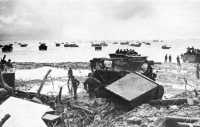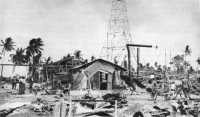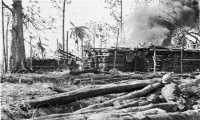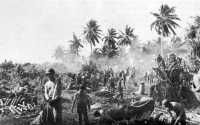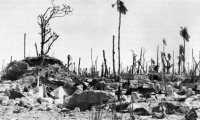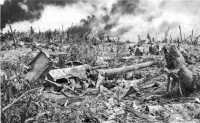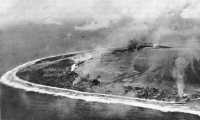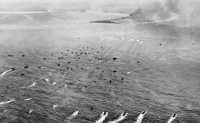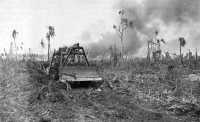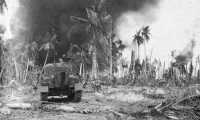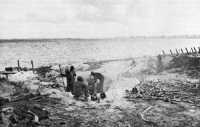Chapter 14: The Invasion of Southern Kwajalein
The Landings on D Day
Occupation of Carter and Cecil Islands
As the Southern Attack Force approached its transport and fire support areas located six to ten miles southwest of Kwajalein, the APDs Overton and Manley slipped ahead in the early morning of 31 January toward the two channel islets that were the first points to be seized by the invading troops.1 Carter (Gea) Island lay about nine miles northwest of Kwajalein Island. A half mile farther, on the opposite side of the channel, was Cecil (Ninni). Each of the two APDs was carrying 155 men organized into a provisional unit, in part from the 7th Cavalry Reconnaissance Troop and in part from Company B, 111th Infantry. Troop A, on Overton, consisted of the headquarters platoon of the reconnaissance troop plus sixty-one officers and men of the infantry company, all under command of Capt. Paul B. Gritta. In Troop B, transported on Manley and commanded by 1st Lt. Emmett L. Tiner, the 1st and 3rd Platoons of the reconnaissance troop were supplemented by ninety-three infantry officers and men. Both units were attached for the forthcoming operation to the 17th Regimental Combat Team, under Col. Wayne C. Zimmerman.2
Troop A was to take Cecil Island and Troop B, Carter Island. The islets were tiny, without known defenses, and were assumed to have but small garrisons. Once the two islands were under control, the four platoons of the 7th Cavalry Reconnaissance Troop were to be reunited and taken aboard Overton to their next mission, which was tentatively set as the reconnoitering of Chauncey (Gehh) Island, about one mile northwest of Cecil. The infantry elements of the two provisional units would remain as garrison and defense forces on the channel islands.3
In the darkness of the moonless night, the islands could not be seen from the ships. The sea was running high as the high-speed transports, about 2,600 yards out, each dispatched one motor launch and a number of rubber boats filled with reconnaissance troops followed by the infantry
carried in Higgins boats.4 The plan for landing on each island required that the rubber boats be towed by a launch to within 800 yards of the shore and then be paddled to a rendezvous halfway in. There they were to wait until two men went forward on an electric-powered raft, made a beach reconnaissance, and set up directional lights marking the best landing spot. The rest of the men in the rubber boats were to follow them ashore and, while establishing a beach defense, guide the Higgins boats in with red lights. Leaving the infantry to defend the beach, the two reconnaissance platoons were first to occupy the side of the island nearest the channel and then to reconnoiter and make secure the remainder of the island.
At the outset some delay was encountered in dispatching Troop B from Manley because of the difficulty in finding Carter Island. Then the lead boat mistook Cecil for Carter and by the time this confusion righted itself it was almost daylight. Hence, plans for a preliminary beach reconnaissance were abandoned, and the rubber boats were paddled to shore at the southern end of Carter at 0620. No resistance was met on the beach. Defenses were set up and the infantry boats guided in while a reconnoitering patrol struck through the fringe of brush at the edge of the beach and entered the heavy tropical undergrowth beyond.
The patrol returned without discovering any enemy, and the reconnaissance platoons, with an infantry platoon providing flank and rear protection, pushed off toward an observation tower at the northwest corner of the island. The area around the tower was soon discovered to be unoccupied except for one Japanese soldier, who was killed. The first reconnaissance platoon then turned around to comb back down the island again, concentrating this time on the ocean side. As the skirmish line pushed back into the tangle of undergrowth again, it was suddenly taken under fire from Japanese concealed in a shell crater and surrounding trees. The platoon leader, 2nd Lt. Claude V. Hornbacher, ordered a machine gun set up in the crotch of a tree, and with it in position a covering fire was laid down on the whole area. Under protection of this fire, Sgt. Leonard C. Brink took personal charge of the situation. In ten or fifteen minutes he hurled grenade after grenade into the crater while the machine gun fired over his head. The Japanese replied in kind. Finally, after enemy resistance seemed to have dwindled, Sergeant Brink and other members of the platoon crawled forward and jumped into the hole with knives and bayonets. Within seconds the skirmish was over and nineteen Japanese soldiers were dead at the cost of one American wounded. The island again fell silent. A few more Japanese were flushed from their hiding places near the ocean shore, and by 0930 the capture of Carter Island was completed.
Intelligence materials were gathered up and sent to Admiral Turner’s flagship, Rocky Mount, and at 1000 responsibility for controlling the island was transferred to the infantry elements. The southeast side of the channel was secured.
At the same time that Troop B was seizing Carter, Troop A was engaged in a parallel mission. At 0430 Troop A started from Overton toward what was supposed to be Cecil Island. The craft moved against a strong current and an offshore wind.
Although the rubber boats were cast loose too soon and had to be rounded up and again taken in tow until brought within paddling distance of the shore, they made an unopposed landing at 0545, thirty-five minutes earlier than Troop B’s on Carter. Guide lights were placed and the infantry’s landing craft came in just at daybreak, while the beachhead defense was being established.
After a brief reconnaissance during which four enemy were killed and two captured, Captain Gritta, commanding Troop A, came to the conclusion that he was on the wrong island. He suspected that his party had been landed at Chauncey, the small island next northwest of Cecil. This was confirmed by General Corlett, who at 0810 ordered Troop A to “forget about Chauncey; proceed on regular mission.”5
Leaving a small party of infantrymen to stand guard over a Japanese tugboat stranded near the beach, Captain Gritta embarked the remainder of his troop in rubber boats and proceeded along the reef to Cecil. That island was found to be unoccupied and by 1235 was reported secured.6 The pass into the lagoon could now be swept in preparation for the entry of ships to provide fire support for the landings planned the next day.
Back on Chauncey, Capt. Gilbert Drexel and his men of Company B, 111th Infantry, kept the stranded tugboat under surveillance and started to comb the woods and underbrush thoroughly. An enemy force estimated at 100, which had escaped the initial reconnaissance, engaged the infantry near the center of the island.7 Others appeared on the tugboat, fired on strafing planes and on the American detail left to guard the tugboat, and were in turn taken under fire by Overton. Under orders to move to Cecil, the company broke off the engagement in the woods, which had cost them two deaths in return for an estimated forty-five enemy killed. The infantrymen set up a defensive perimeter for the night and waited for boats to transfer them to Cecil the following day. Chauncey was left for a later date to be cleared of the remaining enemy on it. Only one squad of infantrymen reinforced by members of Overton’s crew were left to guard the stranded tug. On 1 February they were reinforced by a platoon and ordered to set up a perimeter defense at the beach until more troops could be landed to clean out the remnant of Japanese still on the island.8
Carlson and Carlos
The seizure of Carlson and Carlos Islands on D Day was assigned to the 17th Regimental Combat Team. Carlson was to be used for the emplacement of divisional artillery and Carlos for supply dumps and repair stations. The capture of Carlson was considered the most important D-Day mission for the Southern Landing Force because of its proximity to Kwajalein Island and its importance as a site for the forty-eight 105-mm. and twelve 155-mm. howitzers that were to provide artillery support for the main landing the next day.
Carlos and Carlson Islands extended along the reef northwest of Kwajalein.9 Both islands were long and narrow. Carlson was about two-thirds of a mile in length and under 300 yards in width; Carlos about a mile long and 300 yards
wide. Between the two lay a gap of approximately 4,300 yards, but the water over the connecting reef was never deep enough to float even small boats. Reconnaissance flights had revealed on Carlson the presence of radio towers and other installations including a 100-yard finger pier on the lagoon side. It was estimated that a force of from 250 to 300 was stationed on the island to defend it and maintain defense communications there. Carlos Island, it was believed, would contain a much smaller garrison, if any.10
The 17th Regimental Combat Team’s plan called for simultaneous attacks of battalion strength on the northwestern tip of each island.11 The 1st Battalion, Lt. Col. Albert V. Hartl commanding, was to attack Carlos; the 2nd Battalion, commanded by Lt. Col. Edward P. Smith and supported by one platoon of Company A, 708th Amphibian Tank Battalion, was to land on Carlson. The 3rd Battalion, Lt. Col. Lee Wallace commanding, was to remain afloat in landing craft at the line of departure and be available for either island as needed. Two light tanks were designated for the fourth wave of those landing on Carlos and four were allocated to the fourth landing wave for Carlson. The tanks were provided by Company D, 767th Tank Battalion. Company C of the tank battalion was to stand by to provide support missions if called on.
The transports carrying the three battalion landing teams arrived in the transport area six miles to seaward of Carlson at 0544 on 31 January.12 Five LSTs carrying four amphibian tractor groups had already arrived in an assigned area westward from Carlos Island, and on order they moved through the pitch darkness to the transport area to take aboard the assault troops of the first four waves. The men were to disembark from the transports into Higgins boats, move about 600 yards to their assigned LSTs, and then distribute themselves among the amphibian tractors at the rate of fifteen men per vehicle. On order, the LSTs were then to move close in to the line of departure and disgorge their amphibian tractors through their open bow doors.
This complicated maneuver, carried out as it was in total darkness, inevitably resulted in confusion. The LSTs were unable to find the transports until the latter turned on identification lights. This caused delay and Admiral Turner found it necessary to postpone H Hour from 0830 to 0910.13
As the LSTs left the transport area, one pair carried the LVT group taking the 1st Battalion to Carlos, and another pair carried the LVT group conveying the 2nd to Carlson. Other craft followed, including six tank lighters, twelve LCI(G)s equipped with 40-mm. guns and rockets, and an additional LST carrying the fifteen amphibian tanks of Company A, 708th Amphibious Tank Battalion.14
Preparatory naval bombardment opened at 0618 when Pennsylvania and Mississippi commenced firing on the western end of Kwajalein Island. As daylight revealed three enemy merchant ships in the lagoon, these also received fire from the destroyer Ringgold and the cruiser San Francisco. In spite of squally showers and a low ceiling, the first of the carrier planes
reported on station at 0840 to commence the first of many strafing and bombing runs on Kwajalein Island.15 Observation planes later spotted fire for the battleships and cruisers. At 0810 the scheduled plotted bombardment began with shells from four battleships (New Mexico, Mississippi, Idaho, and Pennsylvania), three cruisers (Minneapolis, San Francisco, and New Orleans) and four destroyers (Stevens, McKee, Ringgold, and Sigsbee) systematically striking Carlos, Carlson, Kwajalein, Burton, and Beverly Islands.16
The line of departure for the landing on Carlos lay about 3,000 yards west of the island’s northwestern tip, Harvey Point. The plan called for the first four waves of the 1st Battalion Landing Team to start for the shore in thirty-two LVTs manned by seven officers and 140 enlisted men. Each of the first two waves was to consist of eight amphtracks in staggered rows of four, the two waves to be spaced three minutes apart. The third wave was to contain five armored LVTs in the first row and four in the second. Wave four consisted of more LVTs in a similar formation; wave five, LCMs carrying tanks and self-propelled mounts (75-mm. howitzers); and wave six, standard landing craft carrying one heavy machine gun platoon, battalion headquarters elements, advance personnel of the battalion aid station, and a squad of engineers.17
The ship-to-shore movement proceeded in general according to plan, and the first troops, two infantry platoons and part of the 1st Platoon, Company A, 13th Engineers, reached shore at 0910. They came into a wide, shallow cove near the northwestern end of the island, which seemed wild and uninhabited. On the left, on Harvey Point, and to the right, tall palms could be seen in small groves, but waist-high underbrush interspersed with small patches of bare sand extended across the island directly back of the beachhead line. Vegetation had been only slightly disturbed by the preliminary bombardment. Behind the first two waves of infantrymen were landed a platoon of heavy machine guns, the communications section of the beach and shore parties, forward observers for the mortars, advance elements of the Signal Corps detachment, infantry reserves, light tanks, self-propelled mounts, battalion headquarters elements, and medical personnel. By 1040, the first five waves were ashore. The landings were unopposed.18
The occupation of Carlos was easily accomplished. Company A, which landed on the right, pushed southward along the ocean side of the island; Company C, on the left, made its way across to the lagoon side and then proceeded in a southerly direction. Near the pier on the lagoon shore, men of Company C encountered their first enemy—three unarmed Japanese, whom they promptly killed. Five others in this area were found to have committed suicide. Company A captured seven or eight prisoners in their southward march. When the front had advanced two thirds of the way down the island, Company C halted and Company A took over the entire line. About two hundred yards from the southern point of the island, Company A met a group of nine Japanese, who were cut down by rifle fire as they tried to rush the Americans. The southern point of the
Landings on Carlson island
island was reached by 1400. The force found an observation tower and sheds with a radio in working order. At 1615 the 1st Battalion reported the island secured. No casualties were reported. No prepared defenses had been found.19
Resistance on Carlson Island was expected to be considerably stronger than that on Carlos or any of the other islands occupied on D Day.20 The first four assault waves of the 2nd Battalion Landing Team were carried ashore in amphibian tractors. The later waves approached the reef in LCVPs from which they were obliged to wade in for the last seventy-five yards. The wave formations were similar to those at Carlos, and the support from destroyers and LCI(G)s was the same. The first wave hit the sandy beach at the northwestern corner of Carlson at 0912. The beach was about 300 yards wide with a treeless sandspit at the left and a thin growth of coconut palms behind a shoulder in the coast line at the right. The amphibians crawled up the beach, meeting no resistance. Company E came in on the left and Company F on the right, while Company G was kept in floating reserve, prepared to land at a point near the middle of the island if the tactical situation so required. In the first wave with the rifle squads were rocket grenadiers, demolition engineers, flame thrower operators, and wire-cutting specialists, all of the 13th
Engineers. The second wave landed at 0920, and the third was ashore ten minutes later. LCI gunboats continued their fire until the third wave had landed. Carrier planes strafed and bombed the island, moving to the southeastern extremity by 0938.
Company F on the right pushed straight across the island to the lagoon, and at 0941 swung southeastward for the push along the length of the island. Company E on the left mopped up the northern end before starting down the ocean side, somewhat behind Company F. At 0958 enemy artillery fire from Kwajalein was reported, but by 1120 naval gunfire and an air attack had put a stop to all Japanese shelling from that quarter.21
Meanwhile, a section of the shore party in two amphibian tractors had reconnoitered the reef during the initial landings and selected a route ashore for the four light tanks and four self-propelled 75-mm. howitzers, which came in by 1010.22 The tanks disembarked from their LCMs on the reef and made their way to the shore, minus one vehicle that broke its final drive and remained incapacitated for the rest of the operation. Once ashore, the tanks found passage through the thick underbrush and coral extremely difficult and a second tank was temporarily disabled.23
The infantrymen accompanied by combat engineers continued southeastward toward the communications center, which was almost in the middle of the island, arriving there at 1105.24 The preliminary bombardment had knocked down one radio tower and weakened another as well as smashing the major buildings, even those constructed of reinforced concrete. The enemy fled, offering no resistance as Company F searched the area. Company E on the ocean side discovered three sets of dummy emplacements but only light enemy resistance. Small arms fire fell briefly among the infantrymen as the two companies moved in line abreast southeastward from the radio tower. Only one man was wounded, however. No further opposition was met. By noon the southeastern tip of the island was reached, and at 1210 the battalion reported the island secured. Twenty-one Korean prisoners were captured. No live Japanese were found on the island, although the battalion commander reported, somewhat ambiguously, that “it is believed that some of the Koreans were part Japanese.”25
Development of Positions
The unexpected ease with which Carlson was occupied led to an early landing of the divisional artillery—even before the island was officially declared secured. At 1125 General Corlett sent orders to the 7th Division artillery group to begin getting its pieces ashore.26 This group, commanded by General Arnold, consisted of four battalions of 105-mm. howitzers (31st, 48th, 49th, and 57th Field Artillery), and one battalion of 155-mm. howitzers (145th Field Artillery), plus headquarters, medical, communications, and special troops. The 105-mm. howitzer battalions were loaded mostly on LSTs. The 145th Field Artillery with its 155-mm. pieces had to be loaded on two larger transports—the AKA Virgo and the APA President Polk. Liaison and forward observation parties were on
Demolished Communications Center. Preliminary bombardment destroyed many defensive installations and demoralized the defenders.
Demolished Strongpoint
the transports with the infantry to which they were attached; the five air observers were on three cruisers of the attack force; and the division artillery command party was on Rocky Mount with General Corlett.27
The 155-mm. howitzers with their tractors, equipment, and ammunition were loaded onto LCMs. These craft grounded in three feet of water offshore but the howitzers were hauled to the beach and dragged to their designated areas, where some were ready for registration fire by 1525. However, the last were not emplaced until long after dark.28
The 105-mm. howitzers were, on the other hand, more expeditiously unloaded. Their DUKWs moved with relative ease from their mother LSTs about 1,000 yards offshore to the positions where the batteries were to be emplaced. Certain DUKWs, especially equipped with A-frame hoists mounted in the rear, took their places near the battery positions. The other vehicles with guns aboard were driven one at a time at right angles across the rear ends of the A-frame DUKWs and halted under the hoists. There, each piece was lifted clear of the DUKW that had transported it, lowered to the ground, hooked to the pintle of the same vehicle and pulled into position. Under the most favorable conditions, a whole battalion could be brought into position in seven minutes.29
The 31st Field Artillery Battalion was the first to commence unloading its howitzers. Its DUKWs proceeded from the beach across the island and along the lagoon shore to a spot opposite the battalion area. Then, with the aid of a bulldozer and much tree cutting, they hauled the pieces to a thick coconut grove, unloaded them, and returned to the beach to pick up ammunition. Shortly after 1500 the 105s commenced registration fire on a Kwajalein Island check point, using smoke shells to distinguish their fire from that of the naval vessels, which were concurrently bombarding that island. Observation posts were later established in the radio tower, on the end of the pier, and in an LVT out in the lagoon, while registration was accomplished with the help of an observation plane launched from one of the cruisers.30
The 48th, 49th, and 57th Field Artillery Battalions followed a similar pattern, occupying areas in the center and on the southern half of Carlson Island. At nightfall the last registration fire was being delivered on a check point on Kwajalein Island by the 49th Battalion. Ammunition was being rapidly loaded into DUKWs from beached LSTs, and before dawn a large supply of shells was on hand to support the main attack on Kwajalein.31
The divisional artillery was concentrated within an unusually limited area. The twelve batteries of 105s were crowded together in an area only 900 yards long by 150 yards wide. The guns of the 49th Battalion were at the southeastern end of the island; those of the 57th Battalion in the adjacent area to the northwest on the ocean side of the island; those of the 31st in a zone west of the pier line on the ocean side; and those of the 48th Battalion closely grouped south of the radio tower. The 155-mm. howitzers of the 145th Battalion
105-mm. M2 Howitzers in position on Carlson Island.
were emplaced farthest from Kwajalein Island between two roads near the middle of Carlson. Following registration, the batteries prepared for an irregular schedule of harassing fire on both Kwajalein and Burton Islands so that the enemy would be prevented, if possible, from repairing and reorganizing his defenses.32
The night of D Day on southern Kwajalein found the Southern Attack Force, despite the unfinished business on Chauncey Island, with all its scheduled objectives attained. The channel islands were secured; the channel itself and an anchorage in the lagoon had been swept for mines; and a part of the invading force had entered the lagoon to take stations there. On Carlos and Carlson the Americans were in full possession. During the early afternoon, the 3rd Battalion Landing Team of the 17th Infantry and one platoon of the 31st Field Hospital had been brought ashore on Carlos. By 1200 men of Company A of the 7th Medical Battalion were ashore and operating a collecting station at the beach.33 The 1st Battalion had returned to the northwest section of Carlos and the 3rd Battalion, the reserve force, occupied the southeastern half.
Supply sections of the 7th Division, which had been separated during the journey to the island, had assembled ashore, coordinated their work, arranged their communications, and were beginning to
build dumps. At 1800, on the northern tip of Carlos, a detachment of the 707th Ordnance Company had set up the LVT maintenance shop capable of handling heavy repairs.34 At the southern end of the island a consolidated ammunition dump was prepared during the night and was ready for use by 0800 on 1 February.
Carlson Island was the scene of even greater night activity. As planned, the 7th Division’s headquarters, rear section, had remained on board Admiral Turner’s flagship, Rocky Mount, together with that of the V Amphibious Corps, but during the afternoon the command posts and headquarters had been set up on Carlson by the 2nd Battalion, 17th Infantry, by the division artillery, and by the 7th Division forward echelon, the latter commanded by Brig. Gen. Joseph L. Ready. At 1645 General Corlett, having observed the early landing of the division artillery, ordered harassing fire placed on Kwajalein Island throughout the night. As a result, there was a much longer preliminary artillery bombardment than the one-hour preparation indicated in the plans as a minimum. During the night both Kwajalein and Burton Islands were treated to a continuing harassing fire by the artillery emplaced on Carlson.35
After dark, naval support vessels joined with the artillery to keep a constant harassing fire over Kwajalein and Burton. The larger island was shelled by San Francisco, Idaho, New Mexico, and their screening destroyers, while Burton was covered by the destroyer Hailey. Troops of the 32nd and 184th Regimental Combat Teams had moved during the afternoon from their transports to LSTs, which were spending the night either west of Kwajalein Island or in the lagoon with orders to return to the transport area at 0530. The remaining vessels of the Southern Attack Force operated in waters southwest, south, and southeast of Kwajalein Island with orders to be in the transport area at 0600.36
One of the novel experiments of the Marshalls operation had also been carried out on D Day with successful, although in a sense inconclusive, results. This was the employment for the first time in the Pacific of an underwater demolition team, composed in this instance of both Army and Navy personnel, whose duties were to conduct close reconnaissance of the beaches at the western end of Kwajalein Island and, if necessary, detonate any underwater obstacles found there. At high tide on the morning of 31 January, shortly after 1000, and again at low tide at approximately 1600, this detachment worked its way to points within 300 yards of the beach. Fire from the battleships Pennsylvania and Mississippi covered these intrepid individuals as they ranged over the approaches to the main landing beaches in rubber boats. Having ascertained that surf and reef conditions were satisfactory and that no underwater obstacles or antiboat mines were located off the beaches, they returned without casualty. Since there were no underwater obstacles present, no opportunity was allowed the team to test its detonation equipment technique under combat conditions. Nevertheless, the team performed valuable service later in the operation in the demolition of wrecks, coral heads, and other underwater obstructions along the lagoon shore of the island.37
With all the conditions for a successful landing deemed favorable, Admiral Turner issued the order at 1622 on 31 January that the main assault on the western beaches of Kwajalein Island should proceed the following day. The scheduled time of landing, H Hour, was set at 0930. The attack would be carried out according to the original plan.38
The Landings on Kwajalein Island
Long before sunrise on the morning of 1 February 1944 the Southern Attack Force at Kwajalein Atoll moved from its night cruising dispositions to the positions assigned for the day’s operations against Kwajalein Island. The eight LSTs on which the leading wave of assault troops had spent the night were the first to approach their rendezvous, at 0530, and within half an hour the larger transports and the warships that were to provide fire support were taking stations. At 0618 Mississippi and Pennsylvania took up the harassing fire, which had been maintained during the night by other ships and by the artillery on Carlson.39 Squalls, frequent rain showers, and scudding clouds lowered visibility. They threatened to hamper the attack but not to compel either its postponement or the adoption of the alternative plan for a complicated landing from the lagoon.40 The assault was to be made from the ocean against the western end of Kwajalein Island.
As the sun rose at 0712, Mississippi moved to a range of about 1,500 yards to fire broadsides on visible targets. The other support vessels closed to about the same range when the systematic preparatory fire was begun at 0745. At that time Mississippi switched her salvos to Burton, northeast of Kwajalein, and Pennsylvania, New Mexico, Minneapolis, New Orleans, and San Francisco screened by eight destroyers, directed their main batteries at the western end of Kwajalein Island in direct preparation for the landings. The destroyers Ringgold and Sigsbee entered the lagoon and prepared to prevent inter-island movement by the enemy.41
The preparatory bombardment of Kwajalein Island was unprecedented in the Pacific in both volume and effectiveness. During one period two shells per second were hitting specific targets or areas in the path of the assault troops. The 14-inch naval shells of the battleships were most effective in piercing and destroying reinforced concrete structures. From the cruisers and destroyers, 8-inch and 5-inch shells ploughed into bunkers and tore up the thick growth of pandanus and palm trees. All together on 1 February, almost 7,000 14-inch, 8-inch, and 5-inch shells were fired by supporting naval vessels at Kwajalein Island alone,42 and the bulk of these were expended against the main beaches before the landing. The field artillery on Carlson also joined in the preparatory fire. Its total ammunition expenditure on 1 February against Kwajalein was about 29,000 rounds.43 Finally, aerial bombardment added its bit to the pulverization of Kwajalein’s defenses. At 0810 six Liberators (B-24’s) of the 392nd Bombardment Squadron based on Apamama reported on station. Between 0830 and 0910 they flew above the trajectory of the naval and artillery shells and dropped fifteen 1,000-pound and 2,000-pound bombs on the blockhouse
Effect of Bombardment on Kwajalein. Pre-invasion attacks reduced defensive positions in the beach area to rubble.
Effect of Bombardment on Kwajalein
and dual-purpose twin-mount guns at the northwestern end of Kwajalein Island.44 This was followed almost immediately by bombing and strafing attacks carried out by carrier-based aircraft. From the carriers Enterprise, Yorktown, Belleau Wood, Manila Bay, Corregidor, and Coral Sea, eighteen dive bombers and fifteen torpedo bombers struck the western part of Kwajalein Island while as many fighters strafed the area with machine guns and rockets. All together ninety-six sorties were flown from the carriers in support of the troop landing on Kwajalein Island.45
The results of all this expenditure of explosives were devastating. The damage was so intensive that it is impossible to determine the relative effectiveness of the three types of bombardment—naval, artillery, and air. The area inland of Red Beaches was reduced almost completely to rubble. Concrete emplacements were shattered, coconut trees smashed and flattened, the ground pock-marked with large craters, coral ripped to splinters. As one observer reported, “The entire island looked as if it had been picked up to 20,000 feet and then dropped.”46
The Assault Landings
The first touchdowns were to occur at 0930. As the time for departure approached, ships, amphibian vehicles, and landing craft began to take their assigned places. The line of departure was 5,000 yards northwest of Kwajalein Island, south of the center of Carlson Island, and the transport area was about 3,000 yards southwest of the line.47 Control over the landing waves was vested in the commanding officers of the 184th and 32nd Regimental Combat Teams, who were located on the control ship, a sub-chaser (SC539).48 The LSTs carrying the amphibian tractors went into position about 1,000 yards west of the line of departure, lowered their ramps, and launched their amphtracks with the troops loaded. The tractors began to circle slowly in a column of waves, waiting the signal to move into line. The LSDs Lindenwald, Belle Grove, and Ashland in an area west of the LSTs launched the LCMs containing the medium tanks of Companies A, B, C, and part of D of the 767th Tank Battalion.49 Two small control boats, assigned to keep the landing craft moving toward the shore at proper intervals, took stations just seaward of the line of departure. Near the ends of the line the amphibian tanks of Company A, 708th Amphibian Tank Battalion, circled after being released from their mother LST, waiting to take their wing positions with the first waves to go ashore.50 Farther back in the transport area, the landing craft on the transports were swung out from the decks and launched. They were to carry the supporting waves with extra ammunition and equipment. Two LSTs with high priority supplies and the DUKW groups waited to move near enough to the beaches to send in supplies quickly.51
The northern (left) part of the 500-yard
western shore line had been designated Red Beach 1, and the southern (right) part was Red Beach 2. Preliminary reconnaissance had indicated the existence of the stronger fortifications along the ocean side, and for that reason the combat-seasoned 32nd Regimental Combat Team, under Col. Marc J. Logie, was assigned the landing on Red Beach 2. The 184th Regimental Combat Team, under Col. Curtis D. O’Sullivan, was to land on Red Beach 1 at the same time. The two combat teams were to make their assaults in columns of battalions, led by the 1st Battalion of the 32nd, containing 84 officers and 1,628 enlisted men, and the 3rd Battalion of the 184th, consisting of 73 officers and 1,489 enlisted men. Of the three companies of the 767th Tank Battalion, Company B would support the landing of the 184th on Red Beach 1 and Company A that of the 32nd on Red Beach 2, while Company C would be held in reserve under division control.52
The enemy offered some resistance to the gathering attack in spite of the overwhelming preparatory fire that had already wrecked most of their guns on the western end of Kwajalein Island. A few antiaircraft shells fell among the assembling landing craft, one of them striking an LVT, injuring two men and knocking the vehicle out of action. The rest of the amphibian tractors, separated by about twenty yards between vehicles and about 100 yards between waves, continued to circle under excellent control. Nevertheless, one accidental collision between two amphibians occurred, damaging one of them and interfering slightly with the landing schedule.53
The first waves of the 3rd Battalion, 184th, commanded by Lt. Col. William P. Walker, and of the 1st Battalion, 32nd, under Lt. Col. Ernest H. Bearss, started for the shore precisely on time at 0900 after receiving the signal from the control boat.54 The LVTs mounted at least two, sometimes three, machine guns each, and, in addition, twenty of them had specially mounted infantry-type flame throwers that could be operated from the assistant driver’s seat.55 At each outside wing and in the center between the first two waves, platoons of amphibian tanks were echeloned. From their turrets, 37-mm. guns protruded. Behind the first wave came three succeeding waves of infantry at two-minute intervals.
As the tractors set out for their thirty-minute run from the line of departure to the shore, Navy aircraft strafed the beaches in a last-minute blow. At 0905 artillery and naval ships resumed fire against the beaches and kept it up until 0928, two minutes before the touchdown, after which they moved their fire inland. LCI gunboats added the final touch. Firing from outside the lanes of approach at the northern and southern extremities of the landing area, they let go their 4.5-inch rockets at 1,100 yards from the shore line and again at 800 yards and fired their 20-mm. and 40-mm. guns at still closer ranges. The seventeen amphibian tanks on the wings and in the center, and the tractors in between them also rode in firing. Small arms and mortar fire from the Japanese inflicted few injuries among the incoming troops, and for the most part the waves preserved their formation.56
There was, however, some shifting to the right (south). The steering mechanism of
Invasion of Kwajalein. The preinvasion bombardment
Following the preinvasion bombardment, landing craft head for the beaches
the LVT that had been damaged in the collision caused it to veer from its position and move to the right among the tractors of the 1st Battalion, 32nd Regiment. All the landing vehicles inclined slightly to the right toward the southern boundaries of the boat lanes, and after they crossed the reef the current took them still farther in that direction. The result was some crowding on the south, but not enough to interfere seriously with the landing.57
Artillery fire from Carlson was still falling on the beaches as the LVTs reached positions only thirty-five yards offshore. Thereupon it was shifted to a zone 200 yards inland. Although most of the defensive positions immediately inland of the shore line had been obliterated, shell craters and piles of debris everywhere remained to deter the invaders. The first wave landed on schedule at 0930. In the zone of the 32nd Regimental Combat Team enough of the enemy survived in their underground shelters or filtered back through the curtain of artillery and naval gunfire to greet the attackers with small arms fire and grenades. From a few undestroyed pillboxes inland of the beaches, the Japanese opened up with light mortar and automatic fire—fire heavy enough to cause a few casualties among the first waves.58
As the first troops dropped down from the high sides of the amphtracks into the shallow water or onto the beach itself, most of them ran over the dune and sought shelter behind the wreckage of a sea wall until the artillery and naval fire lifted inland. On Red Beach 1, where the sea wall was almost at the water’s edge, the LVTs were tilted up enough to obtain a fair field of fire inland. On Red Beach 2 the amphibians stopped at the water line, their fire sweeping barely above the men of the 1st Battalion. For about two minutes the men of the first wave on Red Beach 2 waited in the shelter of the sea wall while LVTs poured fire over their heads. Then, while a detail demolished one remaining pillbox on the beach itself, the rest of the men moved forward rapidly to seek out the enemy just beyond the beach.59 On the left, the two assault companies (Companies I and K) of the 3rd Battalion, 184th Infantry, were also making progress. By 1122 both assault battalions were reported to have advanced 150 yards inland against only slight resistance.60
Combat engineers carrying demolition charges and wire cutters were distributed among the first wave of infantrymen and were prepared to clear the way for the second and subsequent waves to move inland. The preparatory fire, however, had been so effective that further demolition work was unnecessary. Both engineers and covering infantry were therefore able to advance inland with the second wave.61
The amphibian tanks of the first line of attack were expected to proceed inland, striking targets found within a hundred yards of the shore. The LVTs in the second and third waves were to move to the flanks and circle back to the ships to bring in the men of the later waves who were embarked in landing craft too deep-drafted to get over the reef. All vehicles met serious difficulties on the beaches. Some found the undestroyed portions of the sea wall too high to cross; others fell into shell holes or
got hung up on high stumps. Most of the tractors, after landing their troops, found lateral movement along the beaches so impeded by the litter left by the first wave of infantrymen and engineers that, instead of adhering to the original plan of moving to the flanks before returning seaward, they turned around on the beach or backed into the water. This caused considerable congestion and slowed the fourth wave’s approach to the shore. Troops in this wave either waded in or waited for the beach to be cleared.62 In spite of these difficulties, the first four waves of both battalion landing teams were ashore within fifteen minutes after the designated H Hour.63
Build-up of the Assault
While some elements of the first four waves pressed forward in the wake of the artillery barrage and others organized the beaches, additional infantry and units of supporting arms and services continued to come ashore throughout the day.
The 32nd Regiment’s forward command party landed at 0950 and set up a command post a few yards inland in the center of Red Beach 2.64 The 184th’s advance command post was established on Red Beach 1 at 1235.65
The light tanks, carried in LCMs, approached the beach in the fifth wave. Stopped on the reef at 0947, the tank lighters discharged their tanks, which then tried to make shore under their own power. Three light tanks were stranded on the reef. All six of the medium tanks of the sixth wave assigned to Red Beach 2 got ashore, but two destined for Red Beach 1 were held up by the reef and an underwater shell hole. After drying out motors and radios, those tanks that had landed struggled inland across the crowded, shell-torn beach and over the sea wall. Most of the tanks succeeded in pushing on, but the marshy land behind Red Beach 2 held four up.66
At 1205 the 2nd and 3rd Platoons, Company A, 767th Tank Battalion, were ordered into shore and, with one casualty on the reef proceeded inland via Blue Beach 1, which was located on the southwest corner of the island to the right of Red Beach 2. The 2nd Platoon was sent forward and the 3rd Platoon remained on the beach in reserve. The 2nd Platoon of Company B reached Red Beach 1 at 1400. It landed without mishap, being guided ashore by four stranded medium tank crewmen of the 1st Platoon who stood on the reef in water up to their armpits and directed the tanks around the underwater hazards. The tanks went forward to support the infantry without delay, using a new route from the beach that had been cleared by bulldozers.67 The 1st Platoon, Company B, and the 2nd Platoon, Company C, brought their twelve mediums in at 1600 while the 1st Battalion, 184th, was still being landed. One medium tank was disabled on the reef; the others went into bivouac. When the 1st and 3rd Platoons, Company C, were sent to Red Beach 2 by error between 1630 and 1700, they were kept ashore overnight and re-embarked late the next day to participate with the 17th Infantry Regiment in the forthcoming operations on Burton Island.68
Bulldozer clears route from beach
M4 medium tanks supporting the infantry
Combat engineers found their problems fewer than had been anticipated. Without much difficulty they cleared the beach of enemy explosives, set up demolition dumps, and replenished forward ammunition supplies. They later joined the shore party engineers in smoothing out the rough passage from the beach to the western section of the island highway (Wallace Road) with bulldozers and in repairing that section of the highway. The first of the supply DUKWs came ashore just before noon. Seven were sent forward over the new route with grenades, 75-mm. shells, and other ammunition.69 The material dropped from the LVTs was gathered by engineers and put in a dump about fifty yards inland. Regimental supply personnel arrived at Red Beach 2 about 1115. They later established a supply point well inland in the wake of the assault forces.70
One platoon of the 184th Regiment’s 81-mm. mortars erroneously landed at 1025 on Red Beach 2, but was quickly moved to Red Beach 1 to support the regiment’s attack.71 Late in the afternoon the 1st Platoon of the 91st Chemical Company, which was attached to the 32nd Regiment, was emplaced near the southern limit of Red Beach 2, having been landed during the morning and early afternoon. Extra ammunition with which to fire night missions, however, was unavailable until early the next morning. The 2nd Platoon, 91st Chemical Company, landed at 1630 on Red Beach 1 in support of the 184th. After having been afloat in landing craft for seven hours, it came ashore in four crowded amphtracks with its mortars unassembled. The weapons were assembled near the lagoon shore about 150 yards from Red Beach 1, and a fire direction center was established near the mortars.72 The Cannon Companies of the two regimental combat teams landed one platoon at a time with each battalion. Some of the 75-mm. howitzers were packed ashore, while others were waterproofed and towed over the reef from landing craft. The howitzers of the 32nd Regiment were emplaced by 1700 in the southwest corner of a natural clearing just beyond the beachhead line, which lay about 250 yards inland.73 As early as 1330 one section of the 184th’s Cannon Company was firing from a position on the lagoon shore line; about three hours later three more pieces were in battery formation with it. The remaining platoon landed about 1900 and went into bivouac.74
Each of the nine battalion landing teams at southern Kwajalein was assigned a collecting platoon of the 7th Medical Battalion. The first to land was the 1st Platoon, Company B, which came in at Red Beach 2 with the 1st Battalion, 32nd Regiment, at 1130. An hour later the 3rd Platoon, Company C, landed on Red Beach 1 with the 3rd Battalion, 184th. Each platoon set up a collecting station on the beach and evacuated casualties by LVTs to the transport. When the shore party medical sections were ready on the beaches, evacuation of casualties was turned over to them, and the collecting platoons, each now reinforced by a second, moved inland from the beaches to set up two collecting stations. Before night, all collecting platoons and headquarters of each medical company
75-mm. Howitzer in Action against enemy positions across the lagoon
were ashore.75 Evacuation of the injured along the highway to the beaches was swift. Because of the small number of casualties, only one platoon was needed to operate a collecting station in each regimental zone. Men of the other two platoons were sent forward to act as litter bearers, thus accelerating the medical service. About 1530 the 7th Infantry Division Medical Battalion headquarters and headquarters detachment established the battalion command post about 200 yards inland, midway between the two beaches. The 1st Platoon, Company D, 7th Infantry Division Medical Battalion, landed some three hours later and was held in reserve near the command post pending the establishment of a clearing station, which was not put into operation until the morning of 4 February.76
On Red Beach 1 a switchboard set up by the 75th JASCO and wire laid by 7th Infantry Division Signal Company elements connected the two regimental command posts with each other and with that of the 7th Division on Carlson Island, and also linked the six battalions with the division artillery batteries. Amphibian tractors laid 4,500 yards of submarine cable along the atoll reef between the two islands. Later, the ebb and flow of the sea dragged the cable over the sharp coral and broke it from time to time, but cable laying details continually repaired the damage.77
The 2nd Battalion, 32nd Regiment, was available for support from the moment the
landings began; its four assault waves had embarked in amphibian tractors and its four supporting waves in landing craft shortly after sunrise. They were ordered ashore at 1035. After the first waves had landed, the LVTs returned to pick up the troops of the four supporting waves at the edge of the reef. Early in the afternoon they reorganized near the beach and started eastward in column of companies. The 3rd Battalion, 32nd, spent most of the day at sea, coming ashore in the afternoon. This battalion, the regimental reserve, was not committed until the next day.78
The 2nd Battalion, 184th Regiment, the support battalion, landed on Red Beach 1 between 1330 and 1630, formed a column of companies to mop up the area behind the 3rd Battalion, and later established a defensive perimeter for the night. The 1st Battalion, in reserve, landed between 1800 and 1930 and crowded into the limited bivouac area near the lagoon.79
Throughout 1 February the Southern Landing Force thus built up its assault and support elements on the western end of Kwajalein Island as rapidly as reef and beaches could be crossed. Their task was relatively easy because of the light opposition encountered on the beaches. The confusion that had marked the landing of assault and support units at Tarawa was nowhere apparent at Kwajalein. Naval, artillery, and aerial bombardment had done their work well. The troops had been carried ashore on schedule and in sufficient number to sustain the assault. The ship-to-shore movement was an eminent success.
